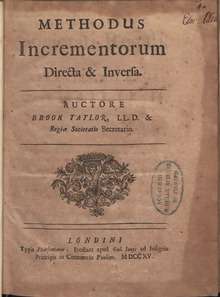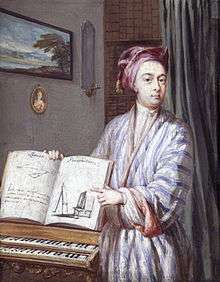Brook Taylor
Brook Taylor FRS (18 August 1685 – 29 December 1731) was an English mathematician who is best known for Taylor's theorem and the Taylor series.
Brook Taylor | |
|---|---|
 Brook Taylor (1685-1731) | |
| Born | 18 August 1685 |
| Died | 29 December 1731 (aged 46) London, England |
| Nationality | English |
| Alma mater | St John's College, Cambridge |
| Known for | Taylor's theorem Taylor series |
| Scientific career | |
| Fields | Mathematician |
| Institutions | St John's College, Cambridge |
| Academic advisors | John Machin and John Keill |
Life and work

Brook Taylor was born in Edmonton (at that time in Middlesex) to John Taylor of Bifrons House in Patrixbourne, Kent, and Olivia Tempest, daughter of Sir Nicholas Tempest, Bart., of Durham.[1]
He entered St John's College, Cambridge, as a fellow-commoner in 1701, and took degrees of LL.B. and LL.D. in 1709 and 1714, respectively.[2] Having studied mathematics under John Machin and John Keill, in 1708 he obtained a solution of the problem of the "centre of oscillation," which, remained unpublished until May 1714,[3] when his claim to priority was disputed by Johann Bernoulli. Taylor's Methodus Incrementorum Directa et Inversa (1715) added a new branch to higher mathematics, now called the "calculus of finite differences". Among other applications, he used it to determine the form of movement of a vibrating string, by him first successfully reduced to mechanical principles. The same work contained the well-known formula known as Taylor's formula, the importance of which remained unrecognized until 1772, when J. L. Lagrange realized its usefulness and termed it "the main foundation of differential calculus".[4][5]
In his 1715 essay Linear Perspective, Taylor set forth the principles of the method in an original and more general form, but the work suffered from the brevity and obscurity which affected most of his writings, and needed further explanation of the concept in the treatises of Joshua Kirby (1754) and Daniel Fournier (1761).[5][6]
Taylor was elected a fellow of the Royal Society early in 1712, and in the same year sat on the committee for adjudicating the claims of Sir Isaac Newton and Gottfried Leibniz, and acted as secretary to the society from 13 January 1714 to 21 October 1718. From 1715 his studies took a philosophical and religious bent. He corresponded in that year with the Comte de Montmort on the subject of Nicolas Malebranche's tenets. Unfinished treatises, On the Jewish Sacrifices and On the Lawfulness of Eating Blood, written on his return from Aix-la-Chapelle in 1719, were afterwards found among his papers.[5]
His marriage in 1721 with Miss Brydges of Wallington, Surrey led to an estrangement from his father, which ended in 1723 after her death in giving birth to a son, who also died. He spent the next two years with his family at Bifrons, and in 1725 he married—this time with his father's approval—Sabetta Sawbridge of Olantigh, Kent, who also died in childbirth in 1730; in this case, however, his daughter, Elizabeth, survived. By the date of his father's death in 1729 he had inherited the Bifrons estate. As a mathematician, he was the only Englishman after Sir Isaac Newton and Roger Cotes capable of holding his own with the Bernoullis, but a great part of the effect of his demonstrations was lost through his failure to express his ideas fully and clearly.[5]
Taylor's fragile health gave way; he fell into a decline, and died aged 46, on 29 December 1731 at Somerset House, London.
Selected writings

A posthumous work entitled Contemplatio Philosophica was printed for private circulation in 1793 by Taylor's grandson, Sir William Young, (2nd Bart., 10 January 1815), prefaced by a life of the author, and with an appendix containing letters addressed to him by Bolingbroke, Bossuet, and others. Several short papers by Taylor were published in Phil. Trans., vols. xxvii to xxxii, including accounts of some interesting experiments in magnetism and capillary attraction. In 1719 he issued an improved version of his work on perspective, with the title New Principles of Linear Perspective, revised by John Colson in 1749, and printed again, with portrait and life of the author, in 1811. A French translation was published in 1757.[7] In Methodus Incrementorum,[8] Taylor gave the first satisfactory investigation of astronomical refraction.[5]
- Taylor, Brook (1715a), Methodus Incrementorum Directa et Inversa, London: William Innys.
- Taylor, Brook (1715b), Linear Perspective: Or, a New Method of Representing Justly All Manner of Objects as They Appear to the Eye in All Situations, London: R. Knaplock, archived from the original on 11 April 2016.
Tribute
Taylor is an impact crater located on the Moon, named in honour of Brook Taylor.[9]
Notes
- Joseph Jopling, Brook Taylor, Dr. Brook Taylor's Principles of Linear Perspective. at Google Books, London, 1835, Memoirs of the Life of the Author.
- "Taylor, Brook (TLR701B)". A Cambridge Alumni Database. University of Cambridge.
- Phil. Trans., vol. xxviii, p. xi.
- "[L]e principal fondement du calcul différentiel". According to François-Joseph Fétis, (Biographie universelle…, p. PA194, at Google Books, vol. 8, p. 194), the statement "the main foundation of differential calculus abstracted from any consideration of infinitely smalls and limits" was first printed in the Journal de l'École polytechnique, vol. 9, p. 5.
- Chisholm, Hugh, ed. (1911). . Encyclopædia Britannica. 26 (11th ed.). Cambridge University Press. pp. 467–468.
- Both are disciples of Taylor's: Marlow Anderson, Victor J. Katz, Robin J. Wilson; Sherlock Holmes in Babylon: And Other Tales of Mathematical History, p. PA309, at Google Books, p. 309
- Nouveaux principes de la perspective linéaire, traduction de deux ouvrages, l'un anglais du Docteur Brook Taylor. L'autre latin, de Monsieur Patrice Murdoch. Avec un essai sur le mélange des couleurs par Newton, p. PP5, at Google Books, 1757. "Patrice Murdoch" is Patrick Murdoch. The name of the publisher and city of publication on the title page are misleading—then a common practice. J. M. Quérard writes that the book was actually published in Lyon ("Murdoch (Patrice)". La France littéraire, ou Dictionnaire…, vol. 6, p. 365); he errs on the name of the translator, who was Antoine Rivoire (1709-1789) (SUDOC record).
- P. 108
- "Planetary Names: Crater, craters: Taylor on Moon". Gazetteer of Planetary Nomenclature. Retrieved 10 June 2016.
Further reading
- Andersen, Kirsti (1992). Brook Taylor's Work on Linear Perspective. Springer Science & Business Media. ISBN 978-1-4612-0935-5.
- Anderson, Marlow; Katz, Victor; Wilson, Robin (2004). Sherlock Holmes in Babylon: And Other Tales of Mathematical History. Mathematical Association of America. p. 309. ISBN 978-0-88385-546-1.
- Carlyle, Edward Irving (1898). . In Lee, Sidney (ed.). Dictionary of National Biography. 55. London: Smith, Elder & Co.
- Feigenbaum, Lenore (1985). "Brook Taylor and the Method of Increments". Archive for History of Exact Sciences. 34 (1–2): 1–140. doi:10.1007/BF00329903.
External links
| Wikiquote has quotations related to: Brook Taylor |
- O'Connor, John J.; Robertson, Edmund F., "Brook Taylor", MacTutor History of Mathematics archive, University of St Andrews.
- Beningbrough Hall has a painting by John Closterman of Taylor aged about 12 with his brothers and sisters. See also NPG 5320: The Children of John Taylor of Bifrons Park
- Brook Taylor's pedigree
- Taylor, a crater on the Moon named after Brook Taylor